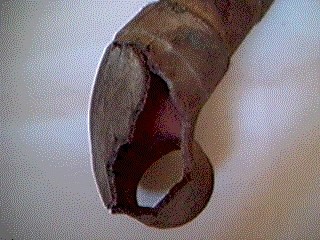The Photo Lab Fire
A mid summer call from an adjuster sent us to look at a multiple user building whose upper floors had been extensively damaged by fire shortly after the end of a hot workday. The building was a fairly large old home that had obviously been renovated numerous times and was currently being rented out to several commercial operations. The provincial Fire Marshall?s office had investigated and been unable to assign a definitive cause to the fire.
The bottom portions of the building were smoke and water damaged but unburned. The fire had begun on the upper floors and spread. Fire usually spreads upward faster than down ward and the responding fire company had arrived in time to save a large portion of the structure. The top floor of the building was occupied by several small commercial operations one of which was an automated photo lab. Several of the reports collected by the fire and insurance investigators from neighbors, reported a loud "whoosh" and the sound of breaking glass immediately prior to the fire.
It was suggested that chemicals stored in the photo development lab had been the cause of the blaze despite the claim by the lab owners that there were no flammable chemicals on the premises and no drums or tins were found.
The building was of wood frame construction, which had dried out over many years and we were able to use well-documented investigation techniques to trace the spread of the fire through the upper floors. The depth of char on the wooden frames over the photo lab was the deepest of all the offices on the upper floor. However within the photo lab itself the char depth was greatest on rafters near the south wall of the lab. In clearing away some of the rubble at the eves of the top of the buildings outer south wall we found a vent pipe which came up from the sewer connections below, through a 90 degree elbow across the attic for a few feet and connected to a roof vent. The piping itself was PVC and although melted and heat distorted, appeared to be intact leading into and away from the copper elbow at the top of the vertical run. The metallic fitting had corroded and split open.
The corroded copper elbow.

The copper fitting, when exposed to the wet sulphur gases and thermal cycling through night and day, winter and summer eventually cracked open. The sewer gases probably accumulated in the attic corner over the photo lab and at some point became concentrated enough to pass over the lower flammability limits for these mixed light hydrocarbons and other flammable vapors. The gases spread to an area in which an air conditioner or perhaps the automated photo processing equipment created the spark that ignited the gas mix. The "whoosh" and breaking glass sound reported by the neighbors is consistent with a small gas explosion.
The copper fitting should not have been part of the installation, there were building codes and inspections that should have prevented this error. The building was quite old, had numerous owners and had been renovated many times. We had no way of determining how or why the metal had become part of the plastic system. While engaged in work for the adjuster at a later date he did not mention how the claim was eventually settled and we did not ask.